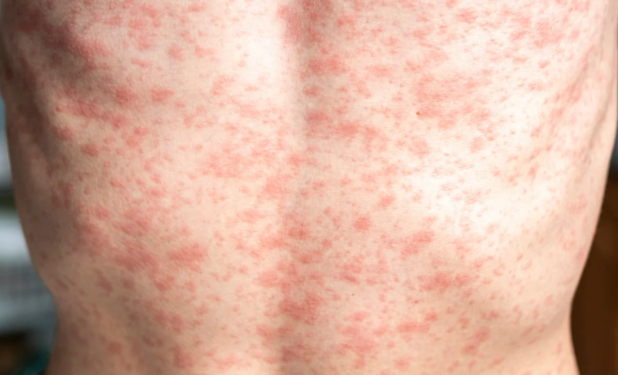As of March 2025, there have been 483 confirmed cases of measles across 20 states. Ninety seven percent of the cases have been in individuals who are not vaccinated or have unknown vaccination status.
There was a recent case of measles in Peublo associated with an unvaccinated person who likely caught the virus while traveling to Mexico. I suspect, we will see more cases.
Infectiousness is often described by the reproduction number of the virus, Ro. Comparing measles to COVID and influenza, measles is much easier to catch. In general, one infected person with measles can transmit to 15 others.
| VIRUS | Ro (infectiousness) |
| INFLUENZA | 1.3 |
| COVID-19 | 2 – 3 |
| MEASLES | 12-18 |
Infection prevention is similar to all other viruses, however, due to the higher Ro the infectivity is greater. You could become infected by simply being in the same room as an infected person. It’s easy to see how a classroom full of children could all become infected if just one child is infectious with the virus.
- Airborne transmission via aerosolized droplets — coughs, sneezes, or breath transmission.
- Lingers in air and on services for up to 2 hours.
- Infected persons are contagious 4 days before the rash and 4 days after it appears.
- Airborne precautions apply.
- Measles is a reportable disease. Report a disease | Colorado Department of Public Health and Environment
The symptoms are similar to other viruses with cough, coryza (runny nose), and cinjuctivitis (red, watery eyes). However, the rash that occurs at about day 3-5 after symptoms start is somewhat pathonogmonic. Koplik spots in the mucosa of the mouth are often seen prior to the rash. The rash occurs in 95% of cases. It usually shows up 3-5 days after symptoms start and is often seen on the face and forehead first, then spreading to the upper body.

Koplic Spots

Maculopapular rash of measles in an adult

Vaccination (MMR) is highly effective and most cases in the US have been in unvaccinated individuals. One dose is recommended for everyone, but 2 doses are recommended for all healthcare workers. It is estimated the 95% vaccination coverage is need for herd immunity to prevent outbreaks.
There is currently no recommendation for a booster for adults. Those born before 1957 are assumed to have had measles and would not need vaccine. Those who were vaccinated from 1957 until 1968 should either get a tighter or a vaccine. The vaccine changed in 1968 and was much more effective.
All healthcare professionals should have had 2 shots.
MMR 1 dose is 93% effective
MMR 2 doses is 97% effective
There are some groups, however, who may be at risk and who may benefit from a dose of the current MMR vaccine. Chiefly, this group includes people born after 1957 and vaccinated before 1968.
A single-dose inactivated measles vaccine used from 1963 to 1967 was later found to not be as effective or long-lasting as the currently used live-attenuated vaccine, experts said.
“Anyone who received an inactivated vaccine between 1963 and 1967 is recommended to receive a dose of the current MMR vaccine,” said Andrew Handel, MD, a pediatric infectious disease physician at Stony Brook Medicine in New York.
Testing
Immediately contact EPCPH Communicable Disease Program for any suspect measles patient – preferably prior to collecting testing – to discuss the risk of measles and the clinical presentation.
EPCPH cannot collect specimens for measles testing but can facilitate testing through the State Public Health Laboratory if warranted.
Collect a throat (oropharyngeal), or NP (nasopharyngeal) swab for measles PCR testing. Use a synthetic swab and place the swab in viral transport media. Urine can be accepted as well, if directed by public health.
Measles IgM serum testing is available through many commercial laboratories. For highly suspicious measles cases, public health recommends sending an IgM (order stat from the lab).
For consultation and assistance with ordering a measles test, providers must call El Paso County Public Health,
Communicable Disease Program:
719-578-3220 (Mon-Fri, 7:30am-4:30pm)
719-235-2278 (24/7 on-call)
Vitamin A and measles: What’s the real story?
Patients may ask about vitamin A after hearing claims that it can help prevent or treat measles. Here’s what we can share:
- Vitamin A is NOT a replacement for vaccination. The measles, mumps and rubella vaccine is the only reliable way to prevent measles.
- Vitamin A supplementation has been shown to reduce measles mortality in malnourished populations in resource-limited countries, where deficiencies are common. In well-nourished populations, the benefits are unclear.
- High-dose vitamin A therapy carries safety risks, including toxicity, liver damage and increased intracranial pressure.
While vitamin A may support treatment in severe cases, it does not stop the spread of measles or provide long-term protection — only vaccination can do that.
The MMR vaccine: Decades of proof that it works
The science is clear: The MMR vaccine is safe, effective and is our best tool for measles prevention.
- Measles cases dropped by over 97% in the U.S. after the vaccine’s introduction.
- Research confirms that the vaccine does not cause autism, a persistent myth fueling vaccine hesitancy.
- The vaccine saves lives — before routine vaccination, hundreds of thousands of children died from measles worldwide each year.
No nutritional supplement offers comparable protection.
Talking to patients about measles, vitamin A and the importance of vaccination
References
- Report a disease | Colorado Department of Public Health and Environment
- https://docshepherd.com/wp-content/uploads/2025/04/Whats-Going-Around-a-Communicable-Disease-Report-March-16-29-2025.pdf
- Report a disease | Colorado Department of Public Health and Environment
- Measles Cases and Outbreaks | Measles (Rubeola) | CDC
- Talking to patients about measles, vitamin A and the importance of vaccination
- RFK Jr. Falsely Claims Measles Vax Causes Deaths ‘Every Year’ | MedPage Today

